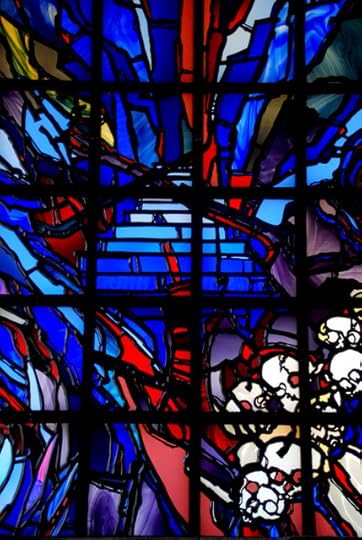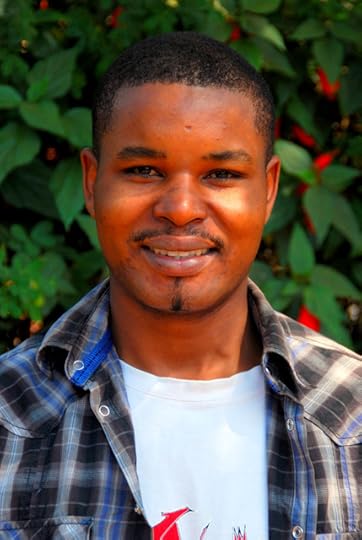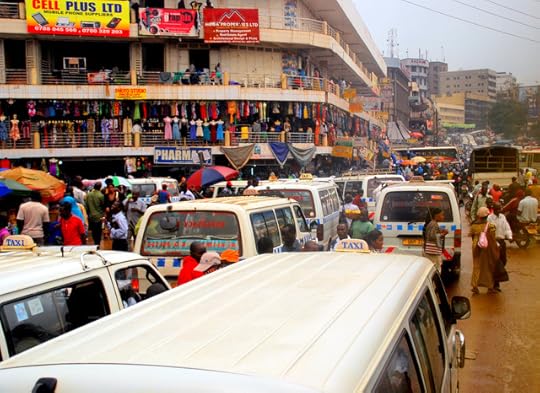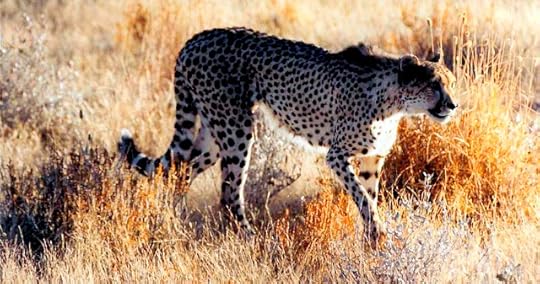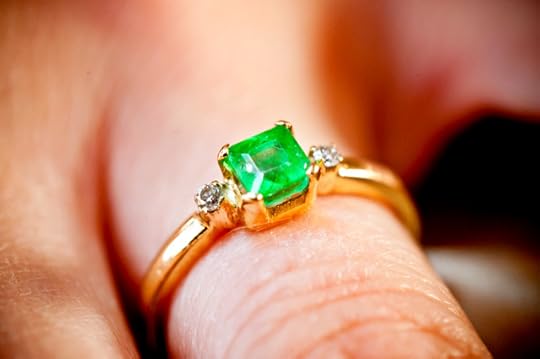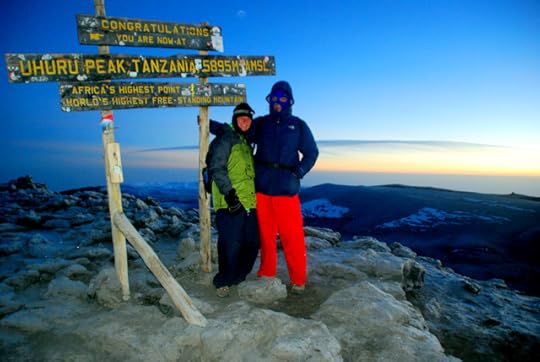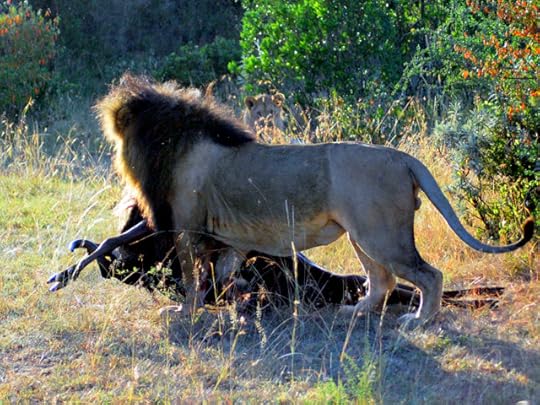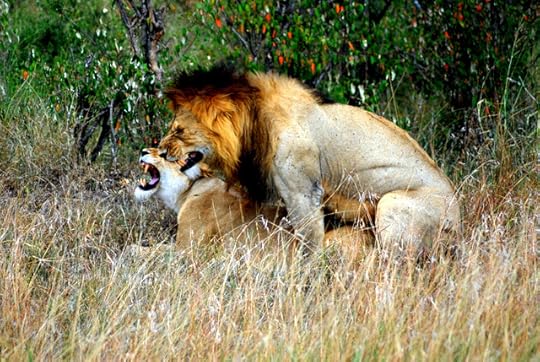Roderick Phillips's Blog, page 2
July 17, 2014
Travels through Rwanda, Day 353
Rwanda is a small country. At 10,000 square miles it is the same size as the state of Maryland, so it’s fairly easy to get around – especially with Patrick our driver-guide and his forest green Toyota Landcruiser (green is Christi’s favorite color so she is already happy). Actually, I probably need to fill in a little of the back story as to why Christi and I are making such a fleeting visit to Rwanda. And despite what you may think from yesterday’s blog on the genocide, we actually came to Rwanda to visit the Mountain Gorillas. Tickets to visit these gentle giants are extremely limited and very expensive. Simply turning up in the height of the summer season and expecting to purchase a couple of tickets is highly unlikely, so Christi and I planned ahead. Of course planning ahead means committing to a date. I booked and paid for our trip with Bizidanny tours 6 months ago. And thank goodness for a little foresight, because I don’t think we could afford to visit the gorillas otherwise. Despite quite extensive research, it was still something of a gamble to use a local Kigali tour operator to organize our trip. Thankfully Patrick and Bizidanny tours are working out just fine.
Today Patrick winds his way through the Rwandan hills (Rwanda is known as the Land of a Thousand Hills) northwest from the capital towards Volcanoes National Park (VNP). VNP is the oldest national park in Africa. It borders Virunga National Park in the Democratic Republic of the Congo and Mgahinga Gorilla National Park in Uganda. VNP is home to 5 of the 8 volcanoes of the Virunga Mountains and these volcanoes are covered with rainforest and bamboo. This unique environment is the perfect habitat for the few remaining Mountain Gorillas. Noted zoologist Dian Fossey studied gorillas in VNP until she her murder there in 1985. Dian Fossey wrote the semi-autobiographical book on which the critically acclaimed movie Gorillas in the Mist was based.
Much of the landscape on our way to Ruhengeri, the nearest town to the national park, is rugged peaks. Yet even under these difficult circumstances agricultural terraces are common. Almost as common in fact as the groups of young boys we meet. They all appear happy and excited to see us. I didn’t know I had that effect on people. It couldn’t be Christi and her blonde hair could it? We also complete a scenic loop of beautiful Lake Burera before finding our way to La Palme Hotel in Ruhengeri. It’s another tourist hotel, but in our present penurious state it seems magnificently luxurious to Christi and I. Although there is no guarantee we will find the Mountain Gorillas tomorrow, we go bed full of nervous excitement like children on Christmas Eve.
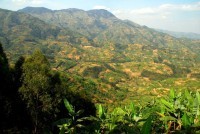
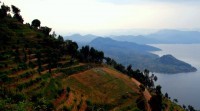
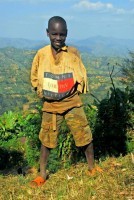
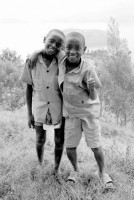
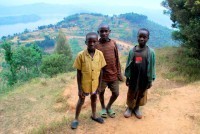
Blog post by Roderick Phillips, author of Weary Heart – a gut-wrenching tale of love and test tubes.
The post Travels through Rwanda, Day 353 appeared first on Roderick Phillips.
July 16, 2014
Rwanda’s genocide, Day 352
There is a spectacular dichotomy about life in Rwanda. In 1994, at a time when the rest of the world was grappling with a new fangled invention called the internet and learning how to send e-mails, the people of Rwanda were embroiled in a 3-month period of genocide where an estimated 80,000 people lost their lives – often hacked to death by their neighbors. And yet as Christi and I begin our exploration of the capital, Kigali, you would not believe – at least at a superficial level – that the country had only recently embarked upon this self-destructive genocide. The streets of Kigali are the cleanest in Africa, probably cleaner than most European cities. The median age in Rwanda is only 18 (for obvious and appalling reasons), which means the people are young, energetic, and there is sense that the future is bright and full of possibilities. Let’s hope Rwanda’s recovery continues and its ugly past does not surface again, although quite how you forgive your neighbor for murdering your father or raping your mother is beyond me.
The roots of this tragedy lie, of course, with the European colonization of Africa in the 19th century. The continent was carved up and countries created without regard for the existing territories inhabited by the indigenous Peoples. Time and again the British, French, Dutch, Portuguese, Germans, and Spanish exploited Africa to their own ends. And yet none of these countries were directly to blame for the events that transpired in Rwanda. On this occasion it was a European minnow, Belgium, that set in place events that a hundred simmering years later exploded into grotesque violence. There are two major ethnic groups in Rwanda, the majority Hutu (84% of the population) and the minority Tutsi (15%). However, the Belgians concentrated power among the Tutsi and effectively disenfranchised the Hutu. By the early 1990′s, and despite the President’s of Rwanda and neighboring Burundi both being moderate Hutu leaders, extremist Hutu were planning their ‘Final Solution’ – the elimination of all Tutsi from Rwanda. On April 6th 1994 a plane carrying both Hutu presidents was shot down on its approach to Kigali airport (most likely by Hutu extremists, but the attack was conveniently blamed on the Tutsi), providing an excuse to begin the genocide.
Out of a population of 7.3 million people, it has been estimated that 1,174,000 people were killed in the 100 days of the genocide (that’s 10,000 murdered every day, 400 every hour, 7 every minute). It is further estimated that only 300,000 (out of an original population of 1.1 million) Tutsi survived the genocide. Thousands of widows, many of whom were subjected to rape, are now HIV-positive. There were about 400,000 orphans and nearly 85,000 of them were forced to become heads of families, like our driver-guide, Patrick.
We learn this and more at the Kigali Memorial Centre, which is built on mass graves containing an estimated 250,000 bodies. Everything in Rwanda at this time is estimated because no one knows for sure exactly how many people were killed, who was guilty and who was innocent. And if the Rwandan genocide is not a sufficiently sobering event, then the museum has information on other equally grim examples of the evil that men do including the Jewish Holocaust, the Balkans conflict, Armenia, and Cambodia to name but a few. It is a very disturbing day and for me at least difficult it is difficult to comprehend even a single murder, let alone death on such a massive scale. One sliver of light on such a grim day is a visit to the hotel made famous in the movie Hotel Rwanda, the Hôtel des Mille Collines. Here, Paul Rusesabagina, the hotel manager played by Don Cheadle in the movie hid and protected 1,268 Hutu and Tutsi refugees during the genocide. He is Hutu; his wife is Tutsi. Now that is inspiring.

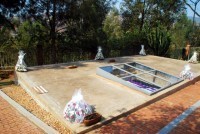
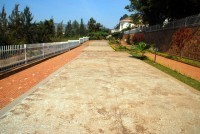
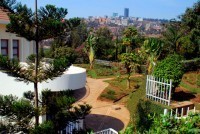
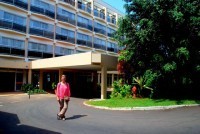
Blog post by Roderick Phillips, author of Weary Heart – a gut-wrenching tale of love and test tubes.
The post Rwanda’s genocide, Day 352 appeared first on Roderick Phillips.
July 15, 2014
Kampala, Uganda, to Kigali, Rwanda, Day 351
Our visit to Uganda has been brief and we must continue on to Rwanda as Christi and I have very special tickets waiting for us in the capital, Kigali. One could quite reasonably ask what was the point of visiting Uganda in the first place? I have two answers. First, we do try to travel overland as much as possible, although there are occasions where a 2-hour flight is preferable to 2+ days in cramped public transport (Gambia to Mauritania springs readily to mind for example). Second, bus travel is cheaper than flying and as we come to the end of our Year of Wonder money slips through our fingers like grains of sand. Our time in Kampala was not without its reward, though, as we were able to plan a few activities upon our return as well as for life after Africa (technically our Year of Wonder ends in two weeks, but that date is a little hazy as the person renting our apartment in San Francisco is keen to stay longer. So while she pays our mortgage Christi and I can continue to play – but not in Africa. Western civilization beckons, my friends!). I’m getting a little side-tracked, here; let’s get back to the action.
Our Kampala Coaches bus service to Kigali in Rwanda is a night departure. This is not ideal, but there are few options. We almost miss the 10 pm departure because even at that hour Arua Park is sheer bedlam. We arrive so late in fact that all storage in the hold is full and our bags don’t fit in the overhead compartment on the bus so we have to put them in the aisle. And since our seats are at the front of the bus our bags are a major inconvenience to the other passengers. We are, as we were for the ride from Nairobi to Kampala, the only caucasian travelers on the bus. This should have been our first warning. What follows over the next 10+ hours is the scariest, most harrowing, ride of my life. I am convinced we will crash and die in a furnace of twisted metal. Clearly the driver of this bus is mentally unstable. Couple this with the single lane road (not single in each direction, note, but simply one tarmac-covered lane with wide soft shoulders either side). The approach of our driver appears to be one of bullying other vehicles, cart, herds of animals etc out of the way, which is a successful if not entirely humane plan. However, there are bigger vehicles on the road than our bus. Both Uganda and Rwanda are land-locked countries and virtually everything is brought into these countries on huge juggernauts from the Kenyan port of Mombasa. And these truck drivers take no shit from anyone, let alone a lowly bus driver. Time and again we play the game of chicken and our bus ends up breaking hard, swerving onto the soft shoulder, and swaying nightmarishly from side to side before coming to a complete halt as the on-rushing, unforgiving juggernauts plow on into the night. The road winds up into mountains and there in the middle of nowhere in absolutely freezing, foggy conditions (and Christi and I were far from properly attired – although my body might be shaking for other reasons) the bus stops. After some quite considerable confusion we realize we have reached the border with Rwanda and we need to negotiate customs and immigration. No one seems to know what is going on and visibility is so poor it is difficult to even find the right shack. And not only are we the only Caucasians on the bus, we are the only Caucasians among several hundred people waiting to complete border formalities. Christi and I are never threatened, but we are the center of attention which adds an additional layer of uncomfortableness to a truly miserable ride. We shamelessly use our ‘prestige’ to force our way to the front of the line and complete the paperwork. The only good news is that Rwanda does not charge for visas.
I wasn’t at all sure I would ever see another sunrise and I am frankly emotionally exhausted when we reach Kigali. I jump off the bus, give the driver a disgusted look, and vow never to step foot onto another Kampala Coaches bus as long as I live. We are greeted by Patrick, our driver-guide while we are in Rwanda, who is far too happy for my liking. He takes us to our hotel, the Chez Lando which has a striking resemblance to a retirement community. And at the moment that suits me just fine. Today is a scheduled rest day on our Rwandan program and I happily take to my bed for a few hours.
Later in the day Patrick takes us to Kigali airport. As I mentioned it would to be a cold day in hell before I stepped aboard another Kampala Coaches bus and the only practical alternative is to fly back to Kampala. This is definitely not in the budget, but my life and that of Christi’s justifies the outlay of $428. Mind you, RwandAir do not accept international credit cards (as of 2010, Rwanda was a cash economy) and I don’t have enough cash. Fortunately the RwandAir sales booth at Kigali airport is adjacent to the Bank of Rwanda who agree after a long and painful process to do a cash advance on my credit card. They give me the cash, which I take to the adjacent booth to purchase the tickets. While we wait for all the paperwork and approvals to go through we get to talking to Patrick. His story is, sadly, typical of many families in Rwanda, although his family fared very badly in the genocide of 1994. Patrick was 12 years old at the time. Sixteen of his family were murdered, including both parents. He was left to raise his younger brother and sister. He had to drop out of school and earn money however he could. This and help from NGOs has enabled his younger brother to attend college. Patrick is proud of his brother, but laments that he never had the same opportunity. This does put my dodgy bus ride into some perspective. Return to the retirement hotel and despite it all sleep soundly.

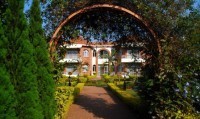
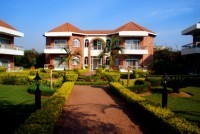

Blog post by Roderick Phillips, author of Weary Heart – a gut-wrenching tale of love and test tubes.
The post Kampala, Uganda, to Kigali, Rwanda, Day 351 appeared first on Roderick Phillips.
July 14, 2014
Faces of Uganda, Day 350
A new day and a new country…and new problems. I’m sure I’ve mentioned this in the past, but just as Christi and I begin to figure things out in a city or country it is time to move on. And of course in those countries that might be considered off the beaten track the problems are more complicated, although potentially the rewards are that much greater. Uganda is definitely not on the mainstream tourist trail, although backpackers often blaze the trail for a future tourist boom (and one could argue NGOs blaze the trail for backpackers and everyone else). Uganda does of course have a troubled recent history as do many countries in this region. Memories of the notorious former leader Idi Amin are still fresh in people’s minds, while the terrorist group the Lords Resistance Army were only recently vanquished, and strife in the Democratic Republic of the Congo is never far away. One could add to that mix strife in Arua Park. Seriously the gridlock in Arua Park makes Nairobi seem like a Formula 1 grand prix circuit. We decide to speed through the problems today by hiring a motorcycle and driver take us to downtown Kampala. Christi and I ride pillion (i.e. on the seat behind the driver). Poor Christi is squashed between myself and driver, a young guy with no fear who zigzags between trucks and cars of all description oblivious to the enraged horns blaring in our direction. Christi and I feel like rag dolls, and in my case at least, very unsafe rag dolls. Actually being hit by a vehicle concerns me less than falling off the bloody bike. Ahh, Kampala, what a city.
The capital of Uganda is not high on our list of favorite places. Most everything is a struggle, beginning with finding some budget tour options. We talk to a few operators, but their prices are astronomical. Not so long ago we would have preferred a private tour, but the money is fast running out. My healthy bank balance has taken a few big hits lately as I purchased flights from Africa to San Francisco (with a layover in the UK), additional travel insurance, onward bus tickets, and our last big-ticket item (more details soon, but for now, I don’t want to spoil the surprise!). Kampala is frantic and frenetic and we are constantly harassed by locals either begging for money or hoping to take us somewhere. Our day is saved in an unlikely way when we splash just a little cash for what we hope will be a pleasant lunch at an Indian restaurant called Haandi overlooking Kampala Road, the main drag. The food is simply excellent and the atmosphere is very relaxing after the tempest that is central Kampala. After ordering garlic naan, basmati rice, vegetable samosas, chicken tikka masala, and vegetable jalfrezi, the staff bring us hot towels to refresh ourselves. At the end of the meal we are given bowls of lemon water to rinse our hands. It’s all so civilized.
Can’t face another motorcycle ride back to the hostel so we taxi instead. I didn’t realize until now that our hostel has its own travel agency and we are able to book some tours around Uganda. But first we’re leaving the country for a few days for the last of our big-ticket items. Any guesses?
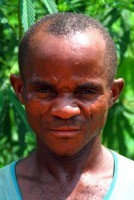
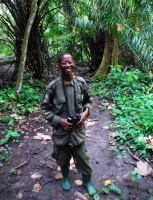
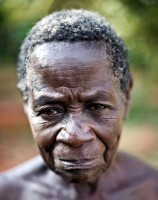
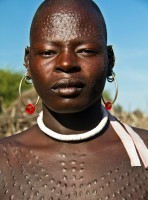
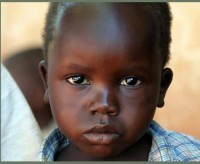

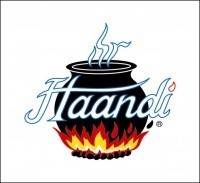
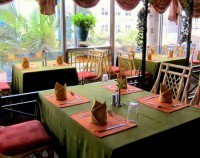
Blog post by Roderick Phillips, author of Weary Heart – a gut-wrenching tale of love and test tubes
The post Faces of Uganda, Day 350 appeared first on Roderick Phillips.
July 13, 2014
Nairobi, Kenya, to Kampala, Uganda, Day 349
Despite the fact that Kampala is in a tense, twitchy state, Christi and I elect to continue on to the Ugandan capital. We are a little nervous to be honest, although with Ugandan security on a heightened sense of alert, now is as probably a safe a time as any to visit. And it’s not as if Nairobi has a glowing reputation for safety; it hasn’t been nicknamed Nairobbery without good reason. Safety aside, I shan’t miss the atrocious roads in and around the Kenyan capital nor the associated traffic chaos. Traffic lights and traffic police attempt to maintain some semblance of control, but it does seem to be a free for all. That the extreme frustration does not descend into violence is a minor miracle. The Kampala Coaches bus is a typical African bus with limited leg room and no on board toilet, yet according to Jocky Tours (with whom we arranged our trips in Kenya), Kampala Coaches have the best reputation for safety and comfort. Clearly the bar is set pretty low around here.
We head northwest through Eldoret (where we stop for lunch) and then continue on to the border town of Malaba (some 300 miles from Nairobi). And just to avoid confusion (or may be to spark confusion), the town on the other side of the border is also called Malaba (some 150 miles to the east of Kampala). Uganda offers single entry visas for US$50 a pop, which means every time you leave and return to have to pay US$50. And this will impact Christi on our travels – bummer. Security is tight, although as appears usual with land border crossings the scenes are quite chaotic. The Western Highlands of Kenya (and presumably Uganda) – which is exactly where we are right now – has a reputation for malaria so Christi and I keep well covered as we negotiate immigration and customs. Our passports have an impressive array of stamps in them now.
Little changes as we cross into Uganda. The roads remain clogged with traffic, especially large trucks moving to and from coastal Mombasa (in Kenya). We do see a quite intense advertizing campaign on our way to Kampala, though. Whole houses are painted in the rival colors of ZAIN (now Airtel) (pink) and MTN telecommunications (yellow). It certainly enlivens the otherwise dull shacks. Progress slows to a crawl at Jinja and remains slow and painful all the way to the main bus station in Kampala at Arua Park. It’s been 13.5 hours and 450 miles of bad road since leaving Nairobi this morning. Arua Park is hell on earth. It is the perfect traffic jam. Nothing moves. Christi and I retrieve our bags and warily and wearily look for a taxi to take us to the Backpackers hostel and campsite, which bills itself as an oasis just 2 km from downtown Kampala. Our taxi driver asks us to pay half the fare (10,000 Ugandan Shillings [US] – less than US$4) upfront. We’re too tired to argue and hand over the money. After we painfully extricate ourselves from Arua Park, our taxi driver pulls into the nearest gas station and puts 4 liters of gasoline into his tank; the fuel gauge on the dashboard anemically crawls off the E.
Perhaps it is a sign to come of our time in Uganda, but as soon as we arrive at the Backpackers hostel the power fails. The restaurant has also just closed so we go to bed tired, hungry, and longing for the Java House in Nairobi.
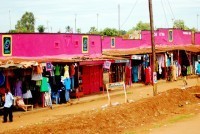

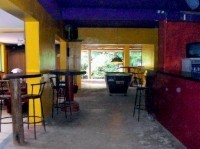

Blog post by Roderick Phillips, author of Weary Heart – a gut-wrenching tale of love and test tubes.
The post Nairobi, Kenya, to Kampala, Uganda, Day 349 appeared first on Roderick Phillips.
July 12, 2014
Kenya redux, Day 348
Oh dear. The Kampala Coaches bus that should be taking Christi and I from Nairobi, capital of Kenya to Kampala, capital of neighboring Uganda (a 12-hour journey) isn’t running today. Of course we only find this out when we get to the bus station at 6 am, our heavy packs slung achingly across our shoulders. Confirm with a shifty looking manager that there is zero chance of leaving Nairobi today. ‘Is it just running late?” I inquire. The manager shakes his head, but seems unwilling to offer further details. “Well, will our tickets still be good for tomorrow?” I ask. This time the manager’s eyebrows shoot up in alarmed fashion, but he grudgingly acknowledges that yes we can travel tomorrow. We return to the Embassy hotel, which is just about as good a place in which to be marooned as any in Nairobi. Christi happens to pick up a copy of the Kenyan Daily Post newspaper whose headline describes several suicide bombs exploding in Kampala, killing 74 people. The people were killed as they watched the world cup final.The terrorist attack was perpetrated by a Somali group called al-Shabaab. So now Christi and I have a decision to make. If the bus does indeed run tomorrow do we want to be on it? Is Kampala safe? While we noodle on this knotty problem, here are a few more photos from our adventures in Kenya to take your minds off the evil that men do.
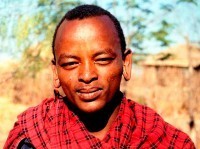

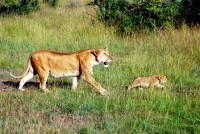
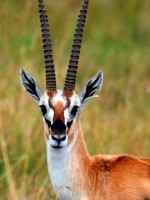
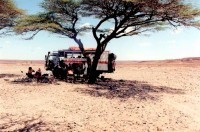
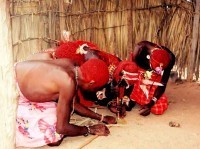
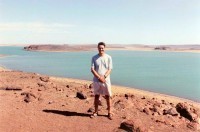
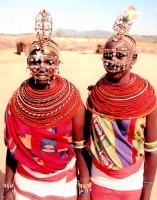
We retreat to the Nairobi Java House for a quite delightful full English breakfast. If you have been on the road for a while and you want a little slice of Western culture, there is no better place than the Java House. Christi and I love it and it is only a couple of blocks from the Embassy hotel as is the jewelry shop where I purchase Christi’s engagement ring. After stuffing ourselves stupid, we waddle over to Tiara Jewels in the Nakumatt Lifestyle shopping mall because Christi says the ring pinches a little. The owners, a very pleasant Indian family, remember me and agree to resize the ring for free. It will take a few hours so we retreat to a nearby internet cafe and read up on the catastrophe in Kampala.
By the time we recover the ring, we’ve made our decision. Tune in tomorrow to find out what we’ve decided to do.
Blog post by Roderick Phillips, author of Weary Heart – a gut-wrenching tale of love and test tubes.
The post Kenya redux, Day 348 appeared first on Roderick Phillips.
July 11, 2014
Kilimanjaro National Park redux, Day 347
This last week has been life-changing on many levels. In case you didn’t quite make it to the bottom of my last mega-blog, I proposed to Christi on the summit of Kilimanjaro and she accepted. We both made it to the Roof of Africa and I finally proposed. Now that is a day I shall never forget. And let’s be honest, not many people propose on bended knee holding an engagement ring on the summit of Kilimanjaro. At the moment I’m feeling pretty good about life. And I am also ecstatic that I am no longer hiking/ trekking/climbing in Kilimanjaro National Park. The hike out was brutal on our already tired and wasted bodies are now on the verge of collapse. Still here is a quick blast to remind you of those carefree moments when I was a single man.
Today is something of a rest day and also my birthday so happy birthday to me (Coincidentally Christi’s is in 10 days time, so right at the end of our Year of Wonder). Apparently my first job as a fiance is to return our equipment to Jocky Tours, while Christi’s first task as a fiancee is to relax at the Java House coffee shop. How did that happen – and on my birthday too! Before I can enjoy my birthday properly (and Christi promises me with sultry look that I will be taken care of) we have to plan our onward travel. Nairobi has been our base for the last few weeks, but it’s time to finally move on. And the lucky destination is…Kampala in Uganda. Once again Christi and I are venturing off the beaten track and it’s back on the challenging African bus system. Our experiences with African buses have been challenging to say the least (in Ethiopia, Sudan, and Morocco to name but three).
With tickets secured we take it up a notch and taxi to Westgate, an upscale shopping mall located in the Westlands neighborhood of Nairobi. As we wander around the high-end Western-style shops it is easy to forget we are still in Africa. And the tug of the familiar and easy lifestyle of home is growing stronger. We eat lunch at a fancy Japanese restaurant called Onami and then go to the movies for the first time in a year. In fact Christi and I have no idea what movies are out and we randomly choose a Matt Damon flick called Green Zone (a thriller set in war-torn Baghdad during the 2003 US invasion). For Christi and I it was a great last day in Nairobi.
Fast forward a couple of years and the Westgate shopping mall takes on the mantle of a war-torn battle zone. A 2013 terrorist attack on the mall (21-24 September) resulted in the death of at least 72 people including 61 civilians, six security personnel, and five attackers, with 175 non-fatal injuries. Three floors of the mall eventually collapsed.

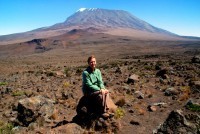
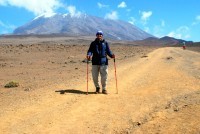
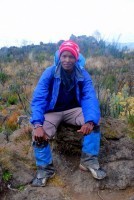
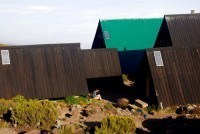
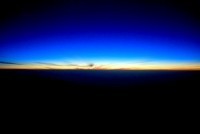
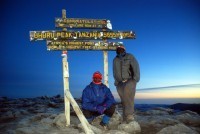
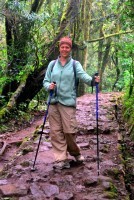
Blog post by Roderick Phillips, author of Weary Heart – a gut-wrenching tale of love and test tubes.
The post Kilimanjaro National Park redux, Day 347 appeared first on Roderick Phillips.
July 3, 2014
Mt. Kilimanjaro, Tanzania, Days 339-346
Even at this late stage in our Year of Wonder, Christi and I continue to punish our aching, weary bodies with extreme activities like attempting to climb Mt. Kilimanjaro. Both Christi and I approach this trip with trepidation: me because I tried climbing a 20,000 ft mountain in South America and failed miserably; Christi because it is not in her DNA to want to climb a peak just ‘because it’s there’ to quote the famous British mountaineer George Leigh Mallory.
Mt. Kilimanjaro National Park is actually in neighboring Tanzania so our first task is to get to the trailhead. And that is easier said than done. The Jamii shuttle service between Nairobi and Arusha is 2 hours late leaving the Kenyan capital on its 170-mile, 5-hour journey. And barely have we reached the suburbs of Nairobi when the shuttle grinds to ear-splitting halt as the second of the shuttle’s two rear axle springs break. I can’t completely blames the Jamii shuttle service as the roads here are in an atrocious state, with potholes the size of the Yellowstone caldera and as deep as the Grand Canyon. We wait 90 minutes for a replacement shuttle to appear. There is little to be seen on the ride as the bus creates its own dust storm, although the driver can see sufficiently well to stop for customs and immigration at the Kenyan / Tanzanian border. Once again Christi’s visa is much more expensive than mine/(US$100 vs. US$50). Thirty minutes beyond the border the rear axle on our replacement Jamii shuttle bus bursts into flames and we are forced to evacuate and quickly recover our bags, which are strapped to the roof. The only way to continue our journey to Arusha, the largest town in northern Tanzania, is for a group of us climbers to hire our own minivan. While someone more proactive than me negotiates the fee, I photograph a few Maasai people who as usual appear out of nowhere. We leave the smoldering Jamii bus and complete the 170-mile journey from Nairobi to Arusha in a total time of 11 hours.
Still tired and grubby after a night in Arusha, we leave the town in the company of our guide (Charles), a cook (Henry) and three un-named and silent porters and lots of supplies and equipment. Apparently it will take a small army of local experts to get Christi and I anywhere near the summit of Mt. Kilimanjaro. There are various trails to the roof of Africa, the most frequently used is the Marangu route. This is the only route to have permanent huts at each of the three campsites on the mountain, which hopefully will make the adventure a little less uncomfortable. Charles offers two pieces of advice which he repeats constantly throughout the climb. Pole, pole (Kiswahili for slowly, slowly) and ‘water is medicine’. To these wise words we add a little 21st century medical magic of our own from Christi’s portable pharmacy in the form of Diamox. The only downside to all the water we drink and the fact that Diamox is a diuretic is that we need to pee frequently – day and night.
Our first hike is 4.5 miles from the Marangu gate trailhead (elevation 6,400 feet) to the Mandara huts at 8,860 feet. We plod along gently (which is our normal pace by the way so Charles does not have to tell us to walk more slowly, although he may wonder whether we will ever arrive) through montane rainforest. We stop frequently to photograph the scenery, which adds further to our hike time. The hike takes 5 hours. The other reason not to hurry is that there is little to do once we get into camp, other than eat and our cook and porters (who double as waiters apparently) do a wonderful job at providing us with varied and plentiful nosh. Interestingly we barely see the porters apart from at meal times and to be honest I am unable to remember their faces, so it’s a good job they recognize me. We eat in a large communal A-frame hut and our territory is staked out with a Maasai blanket which doubles as a table-cloth.
Christi and I sleep okay, but wake to thick mist and fog on the slopes of Kilimanjaro. Even though it is not raining everything is dripping wet outside of our hut. Today we hike 7 miles to Horombo camp at 12,140 feet. The distance and the elevation are both more noticeable today. Charles ambles along sometimes behind, sometimes ahead of us. I think he wants to give us as much independence as possible, but maybe he remains unconvinced of our ability to summit Kilimanjaro. It’s not as though we have done any special training for this climb or attempted to acclimatize ahead of time. Christi and I are truly just winging it this time. Initially the terrain remains montane rainforest, but after a couple of hours we leave the fog, mist, and wet rainforest and enter the alpine zone, dominated by moorland and heather. The sun comes out and we exchange our wet weather gear for sunblock and sunglasses. Some of the more interesting plant species we see are Everlastings (which resemble dried flowers) and Giant Groundsel. We stumble into Horombo camp after nearly 7 hours of gentle hiking. The Horombo huts are filled with people on their way up and on their way down and there is a big difference between the two groups. The people on the way up are nervous-looking and not sure what to expect over the next 48 hours. The people on the way down are tired but overwhelmingly elated. This merely adds to our nervous sense of excitement.
Before we make our summit attempts, Christi and I have an extra day of acclimatization here in Horombo land. Charles takes on a leisurely stroll (5-miles round trip; about 4 hours) to the Saddle (13780 feet) via an interesting formation called Zebra Rocks. Zebra Ass is a more accurate, if slightly less polite, description. We return to Horombo hut at 12,140 feet and over dinner Charles impresses upon us what lies ahead. The summit of Kilimanjaro is 19,341 feet, a vertical elevation gain of 7,000 feet or 1.3 miles straight up – ouch!
After a nervous night we awake to find the montane rainforest below us enveloped in a sea of cloud. We have an early morning start for Kibo hut at the base of the main Kilimanjaro crater. It’s a 6-mile hike across alpine desert (like a lunar or martian landscape). A cold wind blows; it’s a bleak and desolate landscape. And the further we walk the larger Kilimanjaro looms above us. We arrive at Kibo hut at 1.30 pm, 5 hours after departing Horombo campsite. For once we are a little quicker than the average. Kibo hut is at the rarefied altitude of 15,430 feet. The hut is divided into a series of 12-bed dorms; Christi and I share our dorm with a party of very confident German climbers. We have 10 hours to kill before we begin our summit push. There will be no sleep tonight. As usual Charles, Henry, and the porters disappear and only reappear to feed Christi and I. We try to relax, but we feel nervous. We eat a little, checks our packs and equipment, and wait. And wait.
We are among the first to leave camp (so Charles really is worried about our ability to summit!): Christi, me, Charles, and Henry the cook tags along in case one of us can’t make it then the other can continue while Henry brings the other person back to the Kibo hut. It is of course pitch black, although there really are a billion stars in the sky. We can see them when we turn off our headlights. I’m wearing six layers up top, four down below, two pairs of socks and three hats. I look and feel like the Michelin Man, but according to Charles it will be very cold on the summit. We zigzag ever upwards across a vertical scree field, but all we can see is two steps in front of us and the outline of Charles leading the way. Remarkably we reach the crater rim at 4 am (Gilman’s Point, which is 18,650 feet above sea level). Charles had calculated it would take us 6 hours to get this far; we did it in 4.5 hours. This is actually bad news because dawn is still 2 hours away, while Uhuru peak (at an elevation of 19,341 feet) a mere hour further around the rim. This is not a place to dawdle, though. The vicious, biting wind and sub-zero temperatures make for dangerous conditions. We reach the remnants of the once mighty icefield that covered most of the peak at one time and the ice spikes called penitents. I try to take photos, but my battery freezes every few minutes and I have to remove it from my camera with my gloves off (painful) and warm it inside my many layers of clothing. We summit at 6 am - and have the photos to prove it. I am very proud of Christi. We thank the guides profusely, but mostly they want descend as quickly as possible. I, on the other hand, want to savor the moment and take more photos. There is also one other special thing I need to do.
I rummage around my day pack and retrieve a small box. Christi is eager to leave also, complaining about the extreme cold. She is more than a little surprised, therefore, when I go down on bended knee and open the box to reveal an emerald engagement ring (Christi’s preference). “We have had 10 great years together,” I begin, “and our Year of Wonder has been truly spectacular. I should very much like to spend the rest of my life sharing wonderful experiences with you, so Miss Christi Motter would you do me the honor of marrying me. I love you sweetheart.” Christi is shocked – not so much by the proposal, but by the fact that I actually brought an engagement ring with me to the summit of Kilimanjaro (which I purchased just the day before we left Nairobi from Tiara Jewellers and very nice people they are too). After a seemingly long hesitation she says ‘Yes’.
It took us 6.5 hours to reach the roof of Africa and only 3.5 hours to return to Kibo hut. Charles decided that the best way to negotiate the monster scree slope was to run down it. He grabbed a reluctant Christi by the arm and dragged her screaming down the mountain. The climb up Kilimanjaro may have been ‘pole, pole’, but the way back is all about speed. We barely have a moment’s rest, a snack, and time to collect the remainder of our possessions before Charles is urging us back to the Horombo campsite. I do find a few moments to finally place the engagement ring on Christi’s finger, which she was loath to do on the summit. I think all our mental and physical reserves are gone now as the return hike to the Horombo huts takes a long, tedious, and painful 3.5 hours. I can no longer embrace the scenery or the park; I just want this to over. We reach the huts at 3 pm, some 31 hours after we left early yesterday morning. And that is 31 hours without sleep. Henry, our cook, and the porters supply us with plenty of food and drink and Christi and I are in bed and asleep by 7 pm.
We sleep for 12 glorious hours without disturbance. The disappointing news is that we have to make it all the way back to the Marangu gate today and then drive 2 hours back to our hotel in Arusha. It’s an exhausting 12-mile hike with a lunch stop at Mandara hut that we complete in quite grumpy mood in 6.5 tedious hours. We have hiked a grand total of 50 miles over the last 6 days with a vertical elevation change of over 13,000 feet (2.5 vertical miles) and thoroughly deserve the summit certificates awarded to us by the Park and countersigned by Charles.
As we drive back to Arusha, fatigue really begins to set in and our bodies begin to seize up. Say goodbye to Charles and our crew (with tips) and collapse into bed at the hotel. Fortunately our return journey to Nairobi the following day aboard the Riverside shuttle service is unremarkable and completed in the regulation 5 hours. Tonight is yet another auspicious occasion: the world cup final between Spain and Holland. It is a terrible, terrible match. The Dutch game plan is to kick the Spanish team into oblivion, which ultimately fails and Spain claims a 1-0 in extra time.
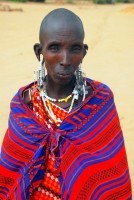

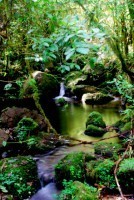
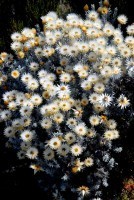
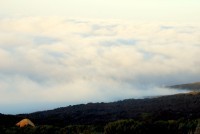
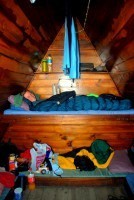


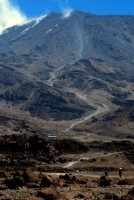
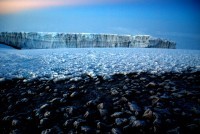
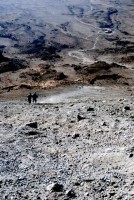
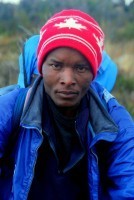
Mega blog post by Rod Phillips, author of Weary Heart – a gut wrenching tale of love and test tubes.
The post Mt. Kilimanjaro, Tanzania, Days 339-346 appeared first on Roderick Phillips.
July 2, 2014
Maasai Mara safari redux, Day 338
Christi and I have very little time to reflect on our recent safari to the Maasai Mara as we prepare for our next adventure, but that shouldn’t stop you from enjoying a few more photos. I would argue that going on safari in Africa is right up there with a visit to the Galapagos Islands for the quality and quantity of the wildlife encounters and in that sense our Year of Wonder is coming full circle (probably not a grammatically accurate statement!). In my wildlife wanderings to date probably only hanging out with grizzly bears in Alaska comes close and without wishing to spoil any future posts on this blog there could be another unique experience coming up. One other wildlife encounter that I would very much like to do is a meet and greet the polar bears of Churchill, Canada – dare I say it – before they are consigned to the history books.
Okay enough safari musings, Christi and I have one day in Nairobi to complete some chores, including the dreaded laundry. I think by now that it is only the dirt that is holding our clothes together. We also make a return visit to Jocky Tours who arranged our safari because this company is also arranging our next great activity. Christi and I are going to attempt to climb Mt. Kilimanjaro – a monster of a mountain at 19,341 feet. If you recall my last attempt at high altitude trekking (on Mt. Parinacota in Bolivia) did not fare so well. Quite why I think I can climb Kili is beyond me and there are some distinct rumblings from Christi who would really rather not set foot on the mountain at all. Indeed, I have to be at my persuasive best to even get her to the offices of Jocky Tours to collect trekking poles, warm weather gear, and goggles for our assault on the mountain. And whereas I actually tried to acclimatize before scaling Parinacota, this time we intend to wing it. Whatever will be will be. The only difference this time is that both Christi and I will take Diamox (which indirectly helps with acclimatizing to high altitude. We used it extensively when we were in the Andes last year) for the whole trek. On my summit day for Parinacota, my guide advised not to take the drug. I did not summit. Would the Diamox have made a difference? I don’t know, but this time I’m all in. I particularly want Christi to make this trip with me, by the way, because I have a surprise waiting for her on the summit of Kilimanjaro. I can’t say anything else for the moment, but stay tuned. This surprise does necessitate me heading off on my own for some alone time. Christi is not happy, although you’d think after 24 / 7 togetherness for the last 11 months, she would be glad to be shot of me for a few hours. Well she isn’t and I have to make up an excuse about visiting an internet cafe to search for information and tips on improving one’s chance of success on Kili. Christi buys this and has no desire to go with me. She chooses to visit the Java House coffee shop and lounge with a good book for a few hours. Perfect.
We reunite for a dining sensation at Carnivore. As the name implies, this is not an establishment for vegans or vegetarians or anyone who does not eat meat – and enjoy it! This restaurant is a meat-eaters paradise. You could literally eat yourself to death here. As the restaurant says ‘It’s a beast of a feast’. All the usual suspects are there such as beef, pork, chicken, and lamb, but this supplemented with a few of the critters we just saw in the Maasai Mara including ostrich, crocodile, and wild turkey. The meal actually begins with soup and salad before kicking it up a gear with as much meat as you can eat. Only when full to bursting do you lower the white of surrender fluttering on each table – and then move on to dessert!! We waddle rather than leave the restaurant. I’m not entirely sure if this is the ideal preparation for climbing Kilimanjaro, but we’re so exhausted we do sleep well. Which I suppose is good news.

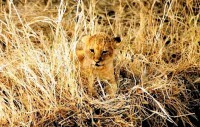
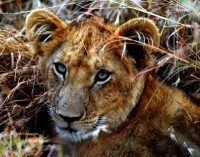

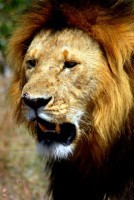
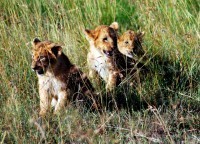
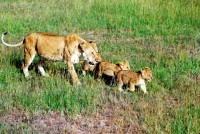

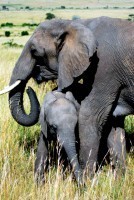
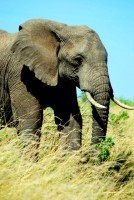
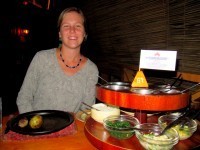
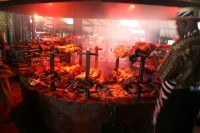
Blog post by Roderick Phillips, author of Weary Heart – a gut-wrenching tale of love and test tubes.
The post Maasai Mara safari redux, Day 338 appeared first on Roderick Phillips.
June 28, 2014
Maasai Mara National Reserve, Kenya, Days 334 – 337
Unlike most people who come to Africa to go on safari, Christi and I did not book our trip to the Maasai Mara National Reserve ahead of time through some flashy-looking website with beautiful images of wildlife (although now that I write that, I realize that is exactly what I am striving for with this blog series. Well, perhaps, the website is not quite in the league of flashy, but I hope in totality and breadth the photos I am posting at least give you the urge to think about traveling!). But I do wonder when I book any foreign trip through a US travel agent / website (which I almost never do) who is the actual vendor. Is it simply a matter of the US travel industry taking a cut and passing the safari reservation to an agency in Nairobi? Now for a regular two-week vacation, I can appreciate having a US-based travel agency arrange everything so that you can relax and enjoy the trip, but since Christi and I are already in Nairobi where agents are falling over themselves to arrange safaris, it seemed much more practical to book our Maasai Mara locally. And I think we got a rather good deal from Jocky Tours. Initially, we discussed joining a larger tour group, but the cost of a private trip was really not that much more so we are embarking upon a 4-day safari to the Maasai Mara National Reserve (technically not a national park as it is not run by the Kenyan government and the Maasai people still have grazing rights). What we get is an 8-seater pop-top minivan, a driver / guide (George) and a cook Matthew.
It’s a long, bumpy drive from Nairobi to the Maasai Mara National Reserve. Considering this route bringing thousands of tourists to the Maasai Mara every year, you might think that the roads would be in much better shape. George explains why that is not the case. Corruption is endemic in Kenya and many officials have to be bribed before construction (often orchestrated by Chinese contractors) can begin. However, by the time all the government officials have been bribed, there is little money left to pay for the work. So rather than build a structurally sound road, a thin layer of asphalt is relaid over the existing pile of debris, which looks great for a week or two and then the pot holes reappear!
We stop twice on our journey out to the Maasai Mara. Once for views over the rift valley (in which the Mara lies) and the second for lunch in Narok, the largest town in the area. No one (apart from me that is) appears in a rush. Part of the reason is that access to the reserve is granted in 24-hour blocks. Although we arranged a 4-day safari, we only have a 3-day pass for the Maasai Mara. Having said that, I am surprised to see wildlife roaming the route to the Mara (giraffe, Thomson’s gazelle, wildebeest, baboons, and zebra to name but a few). Another point that maybe Christi and I should have clarified with Jocky Tours is that our permanent tented accommodation is not actually in the reserve. The way it is described in the brochure makes it sound as if it is, but just to let you know it is not. Instead the Rhino Tourist Camp lies a few minutes outside the Oloolaimutia Gate. Our tent is built onto a concrete base and split into two sections. The front part houses two beds, while the discretely concealed rear of the tent hides a tiled bathroom with sit-down toilet and shower with hot water. A generator provides power between 6 pm and 10 pm to charge the batteries in those fancy cameras! I have no idea where George and Mathew sleep, although Mathew snags a section of a communal dining area for Christi and I to eat (and somewhere hidden from view is a shared kitchen. Apparently, Mathew brought all the food that Christi and I will eat with us from Nairobi). So the things that man control, such as food and accommodation, works well. Spotting wildlife is a whole other story.
Breakfast is at 7 each day and by 7.30 we enter the reserve. And for the next 11 hours (or as long as I can persuade George to stay in the Mara) the search is on for wildlife. And because the Maasai Mara is a premier wildlife area, there are a lot of people and vehicles doing the exact same thing as us. The wildlife seems much more relaxed that the visitors who wait, long lenses at the ready, for something to happen. And there’s the rub. Safari companies are adept at seducing us, the punters, with dramatic images of wildlife, but the Mara is nearly 600 square miles in size and so the odds of any one individual being in the right place at the right time is small. That is not to say that you do not see wildlife. It is there in abundance (herds of giraffe, zebra, elephants, and all manner of antelope) but a lion on a kill? A cheetah playing with its cubs? A leopard stalking its prey? Not so much.
We potter along some dirt tracks around shady nooks or take to the vast open plains in hopes of spotting something spectacular. George is an experienced guide so hopefully he has an idea where we should go, but he is also very quiet. George does not talk, he merely drives. Eventually our persistence pays off, though. We do see a lion on a kill (which it drags hurriedly into the undergrowth to avoid the unwanted attention of a dozen vehicles), a male and female lion mating, and a lioness with cubs. At one point we get a flat tire amid some very tall savannah grass and George very warily gets out of the vehicle to change it. We are told to stay inside, but I never was very good at taking orders and jump down, camera in hand, and step foot on the Maasai Mara . A gazelle appears from nowhere taking me completely by surprise. I had no idea it was it in the long grass not ten feet away. What else could be hiding nearby, I wonder? I edge nearer the minivan and feeling a little more circumspect ease myself aboard. Christi gives me a look that says I told you so! In theory we have timed our visit to the Maasai Mara to see the annual wildebeest migration and we dutifully visit the Mara river which the million or so animals have to cross in order to move from the Serengeti National Park in Tanzania to the lush grasslands of the Mara in Kenya. Once again, though, the wildlife is not cooperating and the wildebeest migration is delayed this year.
It is surprising how much of an appetite one develops on safari, even though we never leave the vehicle. Matthew does a grand job of keeping us well fed. All too soon the adventure is over. I should liked to have stayed longer; being on safari is addictive (the heat and the mosquitoes aside) and one always has the hope that something spectacular will happen right in front of our eyes. Christi has to prise the camera from my hands and then tells George it is okay to leave the reserve. The drive back to Nairobi is rough and the traffic in the capital is unimaginably heavy. A few hours ago I was scanning the horizon as a herd of elephants ambled by, now I’m sucking in pollution and barely moving on the congested streets of Nairobi. It’s a sobering dose of reality when all I want is the fantasy.
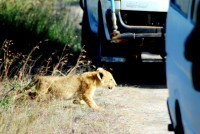
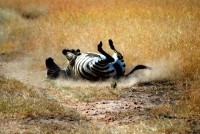
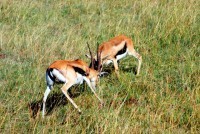
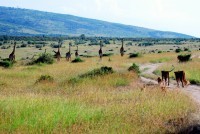
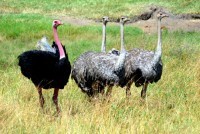
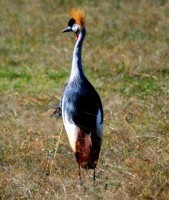
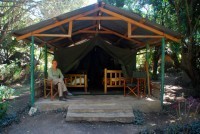
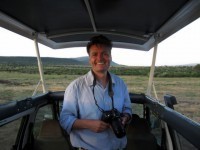
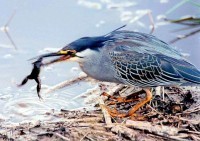
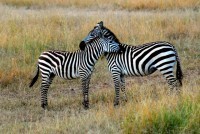
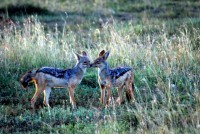
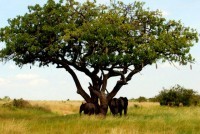
Blog post by Roderick Phillips, author of Weary Heart – a gut-wrenching tale of love and test tubes.
The post Maasai Mara National Reserve, Kenya, Days 334 – 337 appeared first on Roderick Phillips.


